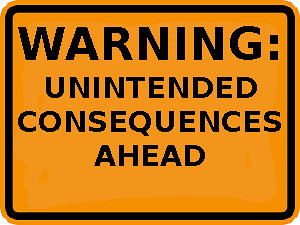
In the already unsexy world of education policy, I’d like to dabble in a subtopic that is even less so: education finance. Before you frantically pound the escape button on your keyboard to back out of this blog, stay with me. I’ll be brief. Plus, you never know what can happen. Remember that Patrick Dempsey from “Can’t Buy Me Love” did eventually become Patrick “McDreamy” Dempsey. One just never knows.
Sometimes the best of intentions in policy and practice can spur unintended consequences that counter original purposes. This is sometimes the case when steps are taken to ensure government accountability, transparency, and frugality in spending taxpayer money. A perfect example is outlined in the superbly reported NPR story about efforts to reduce the budget of one government agency until a little thing known as The Constitution ended up costing us more in the end. Lots more, actually.
I begin by saying that everyone I know in public education is fully supportive of finding the best value for expenditures and fully understands why oversight is needed. We simply don’t have enough money floating around to feel otherwise, even if it wasn’t already a part of our moral code. However, spend a week trying to secure resources or services that are necessary to do our jobs, and you’ll soon discover that some of the best intentions behind state and federal laws are actually backfiring. I can’t help but wondering if our efforts to combat wasteful spending is costing us far more.
Perhaps the most frustrating component of this tale is our inability to take advantage of market pricing, when such pricing is at its best. Or, needing to make a purchase from a company that accepts credit, as all do, but not purchase orders, which many don’t. For example, I attempted to secure a necessary training book for teachers that retails for $28.95. However, digital versions are available for under $10.00, and in some instances less than $5.00. Further, used versions are also found through Amazon. It sounds like a find until you consider we can’t purchase a used book from Amazon due to the strict guidelines on procurement, and the company offering the ebook can’t offer such a low price while absorbing the expense and hassle of purchase order management, while keeping the price low. To get the book, it’s credit card, overpayment, or no critical resource for the classroom teacher.
Remember, we’re constantly reminded that we should operate more like a business
This is only one example from just this past week, but my public education colleagues and I could write something closer to an encyclopedia than a blog, loaded with such examples. On top of these well-intended regulations, school districts have to employ entire departments just to essentially ensure compliance, process mounds of paperwork, and prepare endless reports on spending. Considering that all of our funding is subject to such rules -, well, just think about it for a moment.
In the meantime, I just saved 40 bucks buying something used on Amazon for my home. No purchase order required, just an eye for a deal and a motivation to find the best price.
In the end, there’s nothing more frustrating than to know we are spending more than we should have to, just to prove that we’re not spending more than we have to.









Comments 8
Best. Hook. Ever. Loved this. Thank you for animating a drab topic– a topic that is also extremely important. Great read, Mike.
The humor you started this blog with hooked me in and I couldn’t wait to see what you were going to teach me this week. The ending line sums it up perfectly, are we being efficient? There always seems to be frustration that there is too much “fluff” that can be trimmed, but it seems it can not really be trimmed under current policies and procedures. Thank you for shining a light on this topic and finding such an amazing way to engage your readers!
So true! The soul-sucking reality of school finance is fed on red-tape and purchase orders.
This all supports my idea of giving teachers or departments cash cards at the beginning of the year for expenditures for the classroom and professional development. Then, we document what we do with the card. Perhaps we are rewarded when we procure things at a lower than market rate or something. Honestly I agree with you. It would save money in the long run. I don’t think abuse would be rampant.
I love this idea! If I, as a professional, had my own Pcard (or professional funding stream) to purchase things for MY classroom, I could submit mounds of evidence that shows how my expenditures were justified / resulted in increased student achievement (thank you National Board process for teaching me how to document that). There has to be a balance between public accountability and using individual professional judgment…
Well, he’s not Patrick Dempsey, but Clay Shirky coined the Shirky principle (he couldn’t very well have coined the Dempsey Principle, could he? Anyway – the Shirky principle is that institutes perpetuate the problems they purport to solve. You see similar shenanigans when money has to be spent in a hurry at the end of a fiscal year in order to secure funding for the next year. My wife’s an hourly worker – a school cafeteria manager – It took her team about 1/2 hour more than they were allotted to finish all their work. So instead of paying about $40 more, total, for the whole team, each day, they’re looking to hire another worker, which will end up costing a lot more each day, plus the person will be eligible for benefits which will cost even more. It goes on and on. And I give up, who is Patrick Dempsey?
I’d say Shirky is pretty close to Dempsey!
I can buy the books that my students use on Amazon, used, for one cent, plus $3.95 S&H I kid you not…one cent. However, due to the laws/policies/mandates you have outlined, I can’t actually do that unless I buy them myself or get the parents to do so. Granted, it’s cheap: I can buy 10 books for roughly $40 (with S&H), but buying stuff with my own money got old a long time ago. The clincher is that the books I use are out of print (they’re literature books; I don’t need cutting edge new books, because Shakespeare is the same in used books as in new books), so there’s no way for the district to purchase them, because places that sell used books don’t deal with purchase orders. It’s a case wastefulness caused by laws that were probably intended to create transparency and accountability. If we had more flexibility, we could save money.